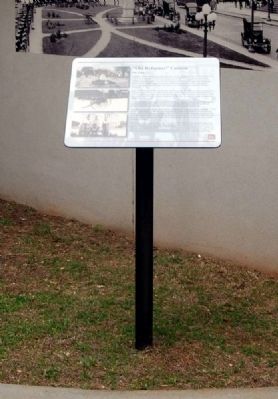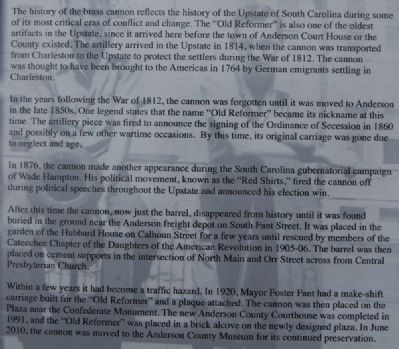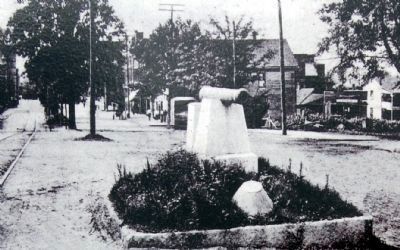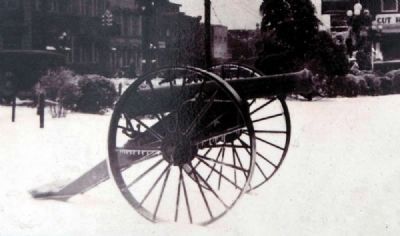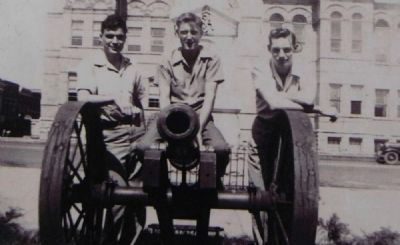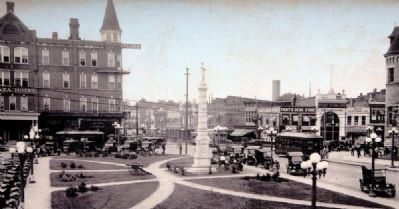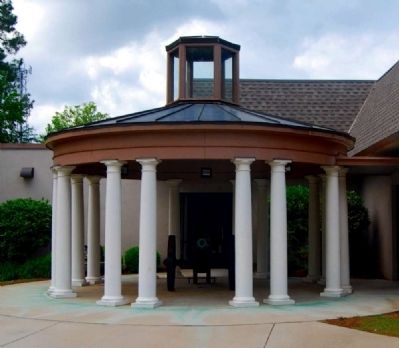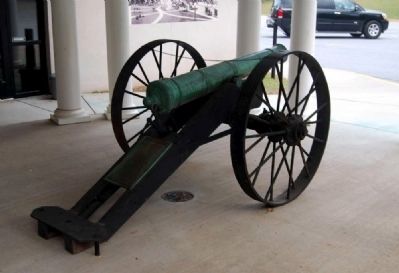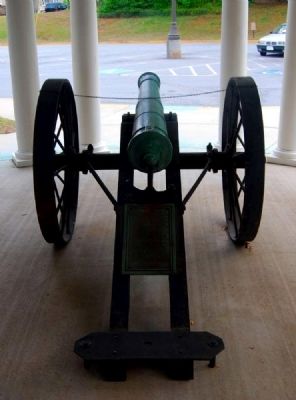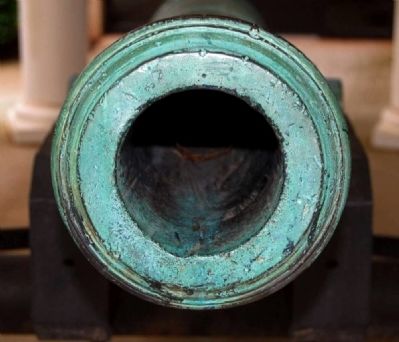Anderson in Anderson County, South Carolina — The American South (South Atlantic)
"Old Reformer" Cannon
ca. 1764
The history of the brass cannon reflects the history of the Upstate of South Carolina during some of its most critical eras of conflict and change. The "Old Reformer" is also one of the oldest artifacts in the Upstate, since it arrived here before the town of Anderson Court House or the County existed. The artillery arrived in the Upstate in 1814, when the cannon was transported from Charleston to the Upstate to protect the settlers during the War of 1812. The cannon was thought to have been brought to the Americas in 1764 by German emigrants settling in Charleston.
In the years following the War of 1812, the cannon was forgotten until it was moved to Anderson in the late 1850s. One legend states that the name "Old Reformer" became its nickname at this time. The artillery piece was fired to announce the signing of the Ordinance of Secession in 1860 and possible on a few other wartime occasions. By this time, its original carriage was gone due to neglect and age.
In 1876, the cannon made another appearance during the South Carolina gubernatorial campaign of Wade Hampton. His political movement, known as the "Red Shirts," fired the cannon off during political speeches throughout the Upstate and announced his election win.
About this time the cannon, now just the barrel, disappeared from history until it was found buried in the ground near the Anderson freight depot on South Fant Street. It was placed in the garden of the Hubbard House on Calhoun Street for a few years until it was rescued by members of the Cateechee Chapter of the Daughters of American Revolution in 1905-06. The barrel was then placed on cement supports at the intersection of North Main and Orr Street across from Central Presbyterian Church.
Within a few years it had become a traffic hazard. In 1920, Mayor Foster Fant had a make-shift carriage built for the "Old Reformer" and a plaque attached. The cannon was then placed on the Plaza near the Confederate Monument. The new Anderson County Courthouse was completed in 1991, and the "Old Reformer" was placed on a brick alcove on the newly designed plaza. In June 2010, the cannon was moved to the Anderson County Museum for its continued preservation.
Erected 2010 by Anderson County Museum.
Topics. This historical marker is listed in these topic lists: Government & Politics • War of 1812. A significant historical month for this entry is June 2010.
Location. 34° 30.601′ N, 82° 38.957′ W. Marker is in Anderson, South Carolina, in Anderson County. Marker can be reached from East Greenville Street (State Highway 81). Marker is located near the museum entrance. Touch for map. Marker is at or near this postal address: 202 East Greenville Street, Anderson SC 29621, United States of America. Touch for directions.
Other nearby markers. At least 10 other markers are within walking distance of this marker. James Lawrence Orr (a few steps from this marker); Orr Monument (a few steps from this marker); Boy High School (a few steps from this marker); Girls High School (a few steps from this marker); The Old Reformer (within shouting distance of this marker); Robert Anderson Memorial Fountain (within shouting distance of this marker); Frierson School House (within shouting distance of this marker); McGee Harness Shop (about 300 feet away, measured in a direct line); Virginia "Jennie" Gilmer (approx. 0.2 miles away); Anderson County Library (approx. ¼ mile away). Touch for a list and map of all markers in Anderson.
Also see . . .
1. War of 1812. The War of 1812 was a military conflict fought between the forces of the United States of America and those of the British Empire. (Submitted on May 6, 2011, by Brian Scott of Anderson, South Carolina.)
2. Wade Hampton III. Wade Hampton III (March 28, 1818 – April 11, 1902) was a Confederate cavalry leader during the American Civil War and afterward a politician from South Carolina, serving as its 77th Governor and as a U.S. Senator. (Submitted on May 6, 2011, by Brian Scott of Anderson, South Carolina.)
3. Red Shirts. The Red Shirts or Redshirts of the Southern United States were white paramilitary groups in the 19th century, active primarily after the formal Reconstruction era of the United States. (Submitted on May 6, 2011, by Brian Scott of Anderson, South Carolina.)
Additional commentary.
1. The Old Reformer Cannon
The "Old Reformer" as it was known, was brought to Anderson by Luke Hanks, an alleged kinsman of Abraham Lincoln, in 1814. Hanks had taken the artillery piece from the old star fort at Ninety Six, where it had been used by the Tories to repel the Americans. The cannon acquired its nickname in 1876, when it was fired to celebrate the election of Governor Wade Hampton and the end of Reconstruction. A Civil War general, Hampton was a descendant of the Revolutionary War hero of the same name. (Source: Touring South Carolina's Revolutionary War Sites by Daniel W. Barefoot (1999) pg 144.)
— Submitted May 6, 2011, by Brian Scott of Anderson, South Carolina.
2. The Old Reformer
This little brass canon of English make was brought to Charleston in 1764 by a group of German immigrants who were befriended by the King of England when they were stranded in London. The king outfitted two ships with goods and arms, including the cannon, for the Germans' voyage to the New World. The cannon is believed to have been used in both the Revolutionary War and the War of 1812. Some years later, Colonel Eliab Moore, a Revolutionary War leader who settled near High Shoals and organized the Fourth Regiment of Militia, in which he served as First Colonel, acquired the cannon for use by his artillery company at Howard's Old Field. It was hauled to this area from Hamburg, a now vanished riverport on the Savannah River, by Luke Hanks. It was said the cannon was fired when Governor George McDuffie came to review the militia at annual musters. In later years Colonel John Moore and his brothers James and Sam (Eliab Moore's grandsons) bought a large tract of land belonging to Thomas Dean. While looking over the property, they found the abandoned cannon and had their nephew, John Smith, haul it to the city of Anderson. The cannon was turned over to Smith's custody since he had served as a sergeant at Fort Moultrie and was well-drilled in artillery. Tradition has it that the cannon's voice blazoned the news of the signing of the Ordinance of Succession in 1860. Smith gave it the name "The Old Reformer."
When the Democratic gubernatorial campaign for Wade Hampton opened in Anderson in 1876, John Smith mounted the cannon on his wagon and carried it to political meetings all over the county and surrounding areas. On one occasion in Abbeville County while Smith was absent, the cannon was fired, loaded with chains and iron spikes. Cuts in the weapon were caused by this. After this campaign, the cannon was abandoned and lay buried in the dirt at the old Anderson depot for a long time. Finally, it was rescued by W.R. Hubbard and placed on his lawn. It remained there until 1905-06 when it was turned over to the Cateechee Chapter, D.A.R., and placed near the intersection of North Main and Orr streets. Eventually it became hazardous to automobile traffic, was removed and again disappeared from sight. It was rescued for a third time during Mayor Foster Fant's first term in office (1920-1922) and at this time it was mounted and placed in front of the courthouse where it stands today. By this time, its fine carriage had rotted away. The iron from the old support had been used during the Civil War to make ploughshares. (Source: Anderson Area Chamber of Commerce.)
— Submitted May 6, 2011, by Brian Scott of Anderson, South Carolina.
3. The Old Reformer Cannon
The little old cannon, now known as "Old Reformer," was brought to Anderson in the early days from Fort Ninety-Six, and its joyful note was
heard on all public occasions. Governor McDuffie used to come to Anderson often to review the militia, and at those times the cannon spoke.
Just when it came to the county is uncertain, as is its previous history. Certainly before 1850 it belonged to an artillery company which was organized by the people living in the sections now known as Deans and Starr. The muster ground was at Howard's Old Field, about one mile east of the present town of Starr. The uniform of that company was copperas trousers and blue coats. The company was in existence in 1832; how much earlier is not known. The little cannon was the object around which they rallied, the detonations of which aroused enthusiasm, and fanned to greater fervor the flame of patriotism which burned in the breasts of the gallant boys.
That company was succeeded by one consisting of 102 men, commanded by Major Thomas Dean; their uniform "was black, jackets and white trousers. The cannon was their only field piece, and dear to their hearts. They built a house on the muster grounds for its safe keeping, and at all general musters it was brought out and put into service. Its reverberations continued to thrill men until the great struggle of the 60s; after that it was made to lend its voice, which is said to be remarkably powerful, to more than one celebration of Confederate victories. After the defeat of the South the cannon, like its people, sank into despondent silence until 1876, when again its joyful note was heard shouting, as did the people, "Hurrah For Hampton.”
Major John B. Moore conceived the idea of rescuing the old cannon from oblivion, and Mr. "Pink” Reed went after it. He found it half covered with dirt out in an old field and brought it to the town. Colonel Hoyt, then editor of The Intelligencer, named it "Old Reformer.”
The cannon is of English make, brass, and was probably used during the Revolution, though there is no authentic account of it at that time, yet there is a tradition that it was used by both British and Americans. It is said to have been transported to Anderson county in 1814 by a man named Hanks, believed by many people to have been the father of Nancy Hanks, who afterwards married Thomas Lincoln, and became the mother of Abraham Lincoln. All that story, however, is pure tradition, and lacks confirmation.
The old brass field piece weighs 600 pounds, and was touched off with a fuse instead of the lanyard of later days. Its fine carriage rotted away more than a hundred years ago. During the war, there being no iron in the county, and no money to buy implements, the iron from the old support was used to make plough shares.
There is a tradition that the cannon was borrowed in December, 1860, from the old muster grounds, and that its voice blazoned the news that the Ordinance of Secession had been signed, after which it was returned to its former place until sixteen years should pass. After the Hampton campaign, it was again forgotten and neglected. For a long time it lay, again half buried in the earth out near the freight depot, and thirty or more years ago the late W. R. Hubbard rescued it, and placed it on his lawn. There it remained until about 1905 or 1906, when Mrs. J.L. McGee, then regent of Cateechee Chapter, Daughters of the American Revolution, interested her chapter in procuring the historic piece and having it placed in a conspicuous position on North Main street, just about opposite to the Central Presbyterian Church. There it stood for several years, until an automobile-crazy city council, after having cut down all of the trees in the street, turned its attention to the little cannon, deciding that it was in the way of speeders, and took it down. Then it disappeared from sight and memory, until Mayor Foster Fant, during his first term, had it mounted and placed in its present position. (Source: Traditons and History of Anderson County by Louise Ayer Vandiver, 1928.)
— Submitted May 6, 2011, by Brian Scott of Anderson, South Carolina.
Credits. This page was last revised on October 14, 2020. It was originally submitted on May 6, 2011, by Brian Scott of Anderson, South Carolina. This page has been viewed 1,931 times since then and 78 times this year. Photos: 1, 2, 3, 4, 5, 6, 7, 8, 9, 10. submitted on May 6, 2011, by Brian Scott of Anderson, South Carolina.
